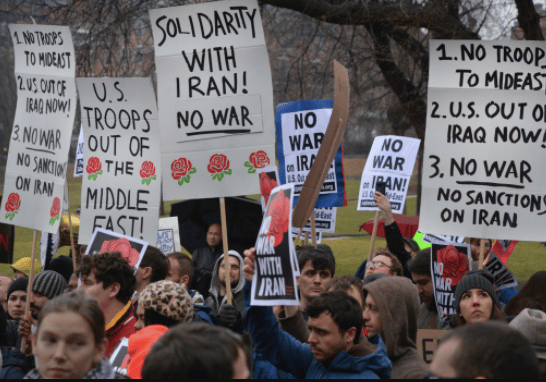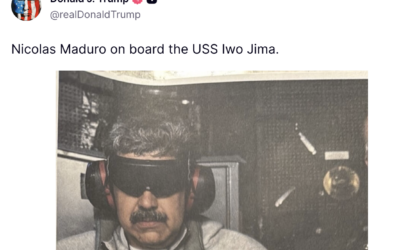The U.S.A. has been bombing Iraq for 29 years. And it looks like it’s not over yet:
Iraq War I: January—February 1991 (aka The Gulf War, Operation Desert Storm, liberation of Kuwait)
Iraq War I 1/2: February 1991—March 2003 (The rest of Bush I, Bill Clinton years, economic blockade and no-fly zone bombings)
Iraq War II: March 2003—December 2011 (aka Operation Iraqi Freedom, W. Bush’s invasion and war for the Shi’ite side)
Iraq War III: August 2014—December 2017 (aka Operation Inherent Resolve, the war against the Islamic State, which America had helped to build up in Syria but then launched this war to destroy, on behalf of the Shi’ite government in Baghdad, after ISIS had seized the predominately Sunni west of the country in the early summer of 2014 and declared the Islamic State “Caliphate”)
Iraq War III 1/2: December 2017—January 2020 (The “mopping-up” war against the remnants of ISIS which has had the U.S. still allied with the very same Shi’ite militias they fought Iraq War II and III for, but are now attacking)
Iraq War IV: Now—?
In 1953, the American CIA overthrew the elected prime minister of Iran in favor of the Shah Reza Pahlavi who ruled a dictatorship there for 26 years until in 1979 a popular revolution overthrew his government and installed the Shi’ite Ayatollah Ruhollah Khomeini in power.
So in 1980, President Jimmy Carter’s government gave Iraq’s Saddam Hussein the green light to invade Iran, a war which the U.S. continued to support throughout the Ronald Reagan years, though they also sold weapons to the Iranian side at times.
But then in 1990, Iraq invaded Kuwait in a dispute over debts from the recent war with Iran, with some encouragement by the U.S. government, leading to America’s Iraq War I, aka the first Gulf War or Operation Desert Storm at the beginning of 1991.
They said it was a quick and easy war, except in the aftermath, again with the encouragement of the U.S. government, the Iraqi majority Shi’ite population in alliance with the Sunni Kurds in Iraq’s north rose up to overthrow Saddam Hussein’s secular, Sunni Arab-dominated dictatorship.
But then President Bush Sr. changed his mind and let Saddam Hussein keep his attack helicopters and enough tanks to crush the uprising, leading to the deaths of more than 100,000 people.
Why did Bush Sr. change his mind? Because the Iraqi “traitors” among the Shi’ites who had chosen religious sect over ethnic and national sect during the 1980s, and had fled to Iran and fought on their side in the Iran-Iraq war, especially the Badr Brigade of the Supreme Council for Islamic Revolution in Iraq, had begun to come across the border from Iran to lead the revolution. The Americans realized they were reversing the 1980s policy of supporting Iraq’s Baathist regime to contain the Iranian Shi’ite revolution and were now importing it into Iraq. So Bush Sr. choked and called it off.
Next, protecting the Shi’ite and Kurdish population the U.S. had just encouraged and betrayed became the excuse for the U.S. to maintain it’s newly expanded military presence in Arabia. It was declared that the U.S. and UK, and originally France as well, would have to maintain “no-fly zones” over northern and southern Iraq for the duration, which were the occasion for hundreds of bombings throughout the 1990s.
At the same time they maintained the pre-war economic blockade against the country in the name of making the people so weak and desperate that they would rise up and overthrow the Hussein government for the U.S. now after their one chance had been spent. Hundreds of thousands of people were deprived to death.
The U.S. military presence in Arabia to wage this half-state of war against Iraq then became the major motivation for bin Laden and his associates, who had fought with U.S. support against the Soviets in Afghanistan in the 1980s, to turn against the United States, which they did, beginning with the first World Trade Center bombing of 1993.
But Israel’s government, and the American neoconservative movement which was closely associated with it, was more concerned about Iran.
In 1996, neoconservative David Wurmser and his associates Richard Perle, Douglas Feith and a few others advised then-incoming Israeli Prime Minister Benjamin Netanyahu that the best way to weaken Iranian influence in Syria and southern Lebanon would be to “focus on removing Saddam Hussein from power in Iraq.” Their friend the Iraqi exile and criminal Ahmed Chalabi, whose “Iraqi National Congress” had its headquarters in Tehran, said it was going to be great. The new Iraq will help America dominate Iran, cut off Hamas and Hezbollah and build an oil and water pipeline to Haifa!
When the consequences of staying in Saudi Arabia after Iraq War I came on September 11, 2001, the U.S. government, led by President George W. Bush, Vice President Dick Cheney and the neoconservatives they had appointed to high office, took the opportunity to launch Iraq War II to overthrow Saddam Hussein in March 2003.
But it did not work out like the neocons had promised.
Instead, essentially all they had done was pick up right where the Bush Sr. government left off. Less than a year into the occupation, the Shi’ite Grand Ayatollah Ali al-Sistani demanded one-man, one-vote democracy. This led directly to the rise of the also-Iranian-backed Shi’ite United Iraqi Alliance, who, under American supervision, wrote Iraq’s new constitution in late 2004 and won total control over the new parliament in the “purple-finger” elections of January 2005.
The Bush government was happy to deal with the Alliance’s Supreme Council for Islamic Revolution in Iraq and Da’wa Party. Every Prime Minster since then has been from these two parties. Defense Secretary Donald Rumsfeld’s military worked hand in glove with SCIRI and their militia, the Badr Corps. This was the very same Iranian-backed militia that had been living in Iran since 1980 and had fought on their side in the Iran-Iraq war; the very same men whose presence among the Shi’ite uprising against Hussein in 1991 had caused Bush’s father to withdraw support for the revolution. Now the U.S. was putting them directly in power.
In 2004 the U.S. launched the “El Salvador Option,” empowering the Badr Brigade to hunt down and torture and murder the leaders of the growing Sunni-based insurgency. General David Petraeus used SCIRI’s Badr Brigade as the core of the new Iraqi Army, and during the “surge” of 2007–2008 helped them win their civil war, giving them total dominance over the capital city of Baghdad and the central government of Iraq, while pushing the Sunni-based insurgency, and ultimately the predominately Sunni western parts of the country into the arms of al Qaeda in Iraq, aka the Islamic State of Iraq (ISI).
But in the middle of all this, they realized their mistake. The Israelis had already decided to play their own game with the Iraqi Kurds. The Saudi king was angry and had been financing the Sunni insurgency against the U.S. and the Shi’ite parties in the war. So the Bush administration decided to launch what they called “the Redirection.”
This was the plan to put the U.S. back on the side of its client Sunni kingdoms in Arabia, allied with Israel, Jordan and Turkey against the newly expanded Shi’ite alliance of Tehran, Damascus, Hezbollah in Southern Lebanon and now Baghdad, to try to somehow make up for the war they had just fought for the Shi’ite government in Iran that they all hated so much.
So that’s why Obama worked with Saudi and other regional allies to back al Qaeda in Iraq in Syria’s uprising against the Iranian-allied Baathist regime in Damascus. He wasn’t a secret Muslim terrorist from Kenya. He was George W. Bush.
However, instead of simply creating a bin Ladenite emirate in eastern Syria that would focus on moving west against the Assad government in Damascus, the Iraqi-led faction of al Qaeda in Syria, ISIS, decided to move east and conquer all of predominately Sunni western Iraq in June 2014. They then declared the establishment of a new bin Ladenite Islamic State straddling the old border between Iraq and Syria.
The “Islamo-fascist caliphate” of George W. Bush’s most ridiculous propaganda and Osama bin Laden’s wildest dreams had come to life – thanks to Bush’s Iraq War II and Obama’s overt action in Syria.
Though they resented the Shi’ites, the establishment of the Sunni-bin Ladenite Islamic State caliphate in Iraq was too much. A sort of Islamist Khmer Rouge, ISIS threatened America’s oil interests in Kurdistan and the Shi’ite regime in Baghdad as well as being an overall “embarrassment” for the Obama government.
So they launched Iraq War III in 2014–2017 to help the Iranian-backed Shi’ite Iraqi government and its paramilitary militias destroy the radical Sunni state they had built to spite the Iranian-Shi’ite regional alliance they had fought Iraq War II for.
Iranian influence in Syria was also only increased during this time as U.S. and allied support for the bin Ladenites necessitated the Assad regime’s turning to Iran and Hezbollah for defense against them, turning Syria from an Iranian ally to a dependent.
Which brings us to the recent conflict. More than 5,000 U.S. troops remain in country fighting Iraq War III 1/2 against what’s left of the ISIS insurgency in western Iraq. It is doing so in cooperation with the Shi’ite-dominated Baghdad government and its paramilitary forces such as the Badr Brigade, Katib Hezbollah and Asaib Al al-Haq.
But over the past six months or so the Israelis, with the cooperation of the U.S. have been launching air strikes against some of these militias. However, when one militia fired rockets at U.S. bases in response on December 27, killing a contractor and wounding two American soldiers, this was labeled the first day in history and pure “Iranian aggression,” though it is unknown whether Iran’s forces were truly involved in the attack.
The U.S. then attacked Katib Hezbollah bases, killing approximately 25 and causing a massive reaction among the major Shi’ite parties and leaders in the country and a controlled semi-riot at the U.S. embassy. No lives were truly threatened but this was clearly seen as a threat of a future Benghazi-type assault on the American embassy there.
In response, on January 3, Trump escalated massively by ordering the killing of the second or third most powerful man in Iran, Qassem Soleimani, the leader of Iran’s Qods Force – essentially their special operations command. Apparently, graffiti implicating Soleimani at the scene of the riot turned into his death warrant. (Endless accusations in the media that Iran and Soleimani were responsible for the deaths of 600 American soldiers in Iraq War II are false.)
It turns out that the protest was led in part by Hadi al-Ameri – the head of SCIRI’s Badr Brigade and member of the ruling coalition in parliament! And now his old close associates David Petraeus and Barack Obama are pretending not to know him.
Ironically, as Patrick Cockburn pointed out, this is all happening right when Iran and Soleimani’s reputation were at a low ebb in Iraq due to the Qods Force helping to organize a lethal over-reaction to the recent protest movement breaking out among the Shi’ites there. That’s over now.
Iran’s response may have come already in the form of the Iraqi Parliament’s vote on Sunday to expel U.S. forces (and file an official complaint against the U.S. at the United Nations).
If Ayatollah Khamenei is smart he’ll take this political victory as good enough and avoid further escalation of the violence, which could cost the U.S., Iraq and Iran all terribly: the U.S. has tens of thousands of troops and a zillion dollars’ worth of equipment within Iranian missile range in Iraq, Afghanistan, Kuwait, Bahrain, Qatar, Saudi, Oman and UAE, as well as economic targets of unquantifiable value all up and down the west side of the Persian Gulf.
At the same time, the U.S. has enough firepower to completely decimate Iran, even without using nuclear weapons, if it came down to a real war. (By the way, is there anything in the world that Ayman al Zawahiri would like to see more than a U.S. war against the mullahs of Iran other than his own rear end on Pharaoh Sisi’s throne in Egypt?)
Mutually assured destruction has kept the relative peace thus far, but Americans should insist that the U.S. military leave Iraq immediately. Iraq War III is over. The “territorial caliphate,” as Trump calls it, has been destroyed and Baghdad’s sovereignty over western Iraq restored. If our best Iraqi allies that we’ve helped win two major wars in the last 17 years are such bad guys that we want to bomb their leaders, then now must be the perfect time to quit this war once and for all.
The U.S.A. has no real reason to fight Iran or their and our Iraqi friends. They do not threaten the American people. They only stand in the way of American political and military dominance over the Middle East. That ship has already sailed. If people are sad that Iran has increased its power and influence over the region in the past 20 years, they need to take that up with George W. Bush and Joe Biden. But there’s nothing we can do about it now.
Again, the U.S. has only a few thousand troops in the country to help these same Shi’ite forces fight against what’s left of AQI/ISIS. We do not have anything like the forces necessary to turn around and fight against the Shi’ite army and militias even if we had a good reason to do so.
Trump claims he ordered this killing to have the last word. To “stop a war not to start one.” As reckless as this is, it does seem to accurately reflect his intention. Secretary of State Pompeo immediately started calling for a time-out on Twitter, insisting that the U.S. was intent on “de-escalating” the conflict from here on.
On Sunday afternoon, Iran announced they were withdrawing from more of the restrictions in the 2015 nuclear deal the U.S. left two years ago. Even if they quit the whole deal now, it would mean little since they are still within the Non-Proliferation Treaty and Safeguards Agreements with the IAEA. However, we can expect the usual suspects to pretend to believe that they are embarking on a new nuclear weapons program starting presently.
But so far there is still no real crisis other than what our government has made.
Twenty-nine years of bombing one country is enough. Starting Iraq War IV out of spite over the results of Iraq Wars II and III would be the height of folly and assuredly an unmitigated disaster.
Instead, let’s call the whole thing off and bring our troops home.
Cross-posted at Antiwar.com.
































